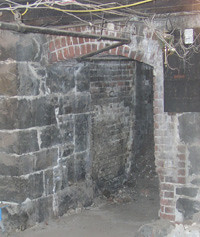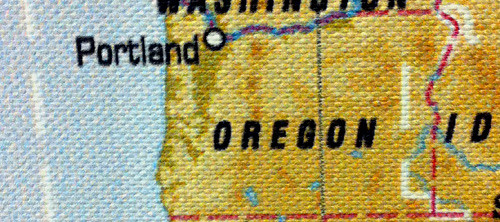Last week, an anonymous post from a reader led me on a midnight wild goose chase on Google in search of information on the legends surrounding Portland's Shanghai Tunnels. As they pointed out, every reference on the topic I could find all pointed back to the Cascade Geographic Society's ghost
tours. I wrote about the search over
here last Wednesday
I later poked around in the online archives of
Willamette Week,
The Portland Mercury and the
Portland Tribune. I didn't find any useful information aside from this
article on a local group called the Northwest Paranormal Investigators and briefly recounts their encounters with the spirits that supposedly haunt the tunnels. Just about everything else led to outdated info on drink specials at the bar of the same name down on 2nd Avenue.
Then a
colleague ran a search through Info Bank's
Oregonian archives via the Multnomah County Library's site and found a few articles written by Portland columnist Phil Stanford, who tackled the subject back in the early nineties. Supposedly, he even talked to a ghost down in the tunnels at one point. I'd like to dig into the articles but Info Bank requires an active library card and mine expired after I left town for college nearly a decade ago. Those will have to wait until I can get a new one at my local branch.
Then along came David Schargel from Portland Walking
Tours who responded to my post on the tunnels with a good chunk of information. He's even more skeptical about the legends than I am and even goes so far as to say that they were never used for shanghaiing or, as it was more commonly known back in the day, "crimping." We've been going back and forth on the topic over the past few days. You can read the whole conversation via a link at the bottom of last week's
post (sorry, it won't let me do a direct link) or the highlights below. Here's what he had to say:

On the tunnels:
"There was never an extensive tunnel system for people to travel in, but there *were* tunnels under Portland. No question about it. The City archives even has a 'underground district' map. It was done by the Portland Railway Light & Power Co. that shows the 600 volt system that powered the old Streetcar system
Most towns cities had tunnels. So what? Here at Portland Walking Tours, we learn about them with the acronym of 'FLUMES':
F - Flood control
L - Loading cargo at 2 river levels
U - Utility tunnels for Streetcar electrical supply
M - Movement of goods for connector buildings
E - Escape routes for gambling parlors, bordellos, etc.
S - Steam Tunnels."
On crimping/shanghaiing:
"OK: Shanghaiing. Yes, it happened in Portland. The proper term is 'crimping' and it's almost as ancient as the shipborne commerce of nations. On the west coast of the US (with San Francisco's Barbary Coast being the main crimping town), it was a very elaborate system that involved 1. a sailor landlord, 2. a drayman, 3. a longshoreman, 4. a sailor lawyer, and 5. a shipping master.
To over simplify the ideas for this posting, suffice it to say that men jumped ship when they arrived at a port city like Portland. Sometimes ship captains (who were not involved in crimping) couldn't pay men when they were in port, so they released them. When a ship needs to leave, they hire a crew. In a port city, that was almost never a problem. But, on occasion, a shipping master could not get enough men on board by the time for sailing. Hence, the elaborate system for tricking and coercing men onto a ship. It didn't happen that much from what I understand, but it did happen. The practice came to an end by the 1880s when Steamer Ships did not require large crews and sailors were easy to come by."
On the legends:
"I haven never seen evidence (or even a need for that matter) of holding cells, broken glass, trap doors (even though they existed for other purposes like moving goods from basement to upper floors). Sorry to burst any bubbles, but the Shanghai Tunnels did not exist.
I'm with you on the potential for prison cells and captured sailors and I could suppose that prison cells would be the only evidence. But I don't think there *are* any cells down there. I've seen bars in windows, but they separate large rooms. I personally think that those barred windows underneath Old Town Pizza are merely for separating the basements of different businesses. Kind of like old-time room dividers.
A good portion of the history of any illicit and shady activities is through oral history and I'm pretty sure that's true in Portland's case too. If you go back to Stewart Holbrook's earliest writings (1930? 31?) about crimping in Portland, it's all oral history. Good stuff too. I was once told by Richard Engeman, the Public Historian at Oregon Historical Society , that he surmised that Spider Johnson (the person quoted by Stewart Holbrook) may be an amalgamation of folks."
My own inconclusive conclusions:
David makes a strong argument but not completely convinced. I, along with probably a lot of other people here in Portland, would like to think there's a shadowy network of tunnels running all the way from the West Hills to the Waterfront. Folklore and a "good story," regardless of how implausible, are almost always more interesting than the facts.

I'm reminded of an old episode of
The Simpson where Lisa tracks down some ugly truths about Springfield's beloved town namesake, Jebediah Springfield. Instead of ruining an annual Jebediah-themed festival with the real story, she opts to keep quiet and perpetuate the widely-held legend. Of course, in the case of the Shanghai Tunnels, the preferred version of history surrounds kidnapping, sex slavery, tormented souls and opium dens. Yikes.
Since little of the legend was ever put in writing and presumably most, if not all, of the current information available on the Shanghai Tunnels exists as oral history, we'll probably never know exactly what went on down there. The truth could fall somewhere in between the shanghaiing stories everyone's heard and...zip. Maybe the tunnels were used for crimping, maybe they weren't. At the very least, all those basements hosted a substantial amount of illicit activities back in Portland's past.
As for the ghosts, well, I didn't see any when I toured the tunnels last year. Are they down there? There's plenty of people that would probably tell you otherwise. I'm curious to read Stanford's stuff on the subject but, as I said earlier, I've got to get myself a valid library card first.





